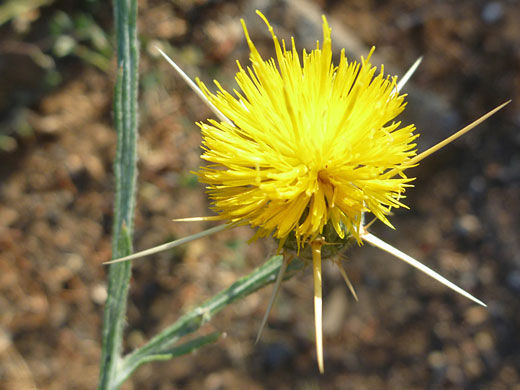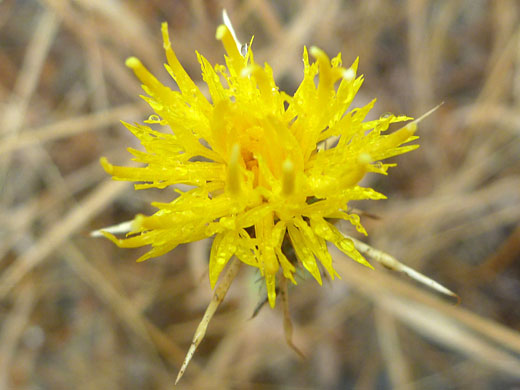Centaurea Solstitialis, Yellow Star Thistle
Plants > Wildflowers > Asteraceae > Centaurea Solstitialis
Common name:
Yellow star thistle
Family:
Scientific name:
Centaurea solstitialis
Main flower color:
Range:
Parts of all the western states; most common towards the west (non-native)
Height:
Up to 3 feet
Habitat:
Fields, roadsides, woodland, disturbed areas
Leaves:
Up to 6 inches long, oblanceolate, lobed; those higher up the stem are entire, and more linear
Season:
May to October
Most species in this genus produce pink or purple flowers, but those of centaurea solstitialis are yellow. The plant is a native of Europe, and has been established in all the US states, most widespread in the West. It is classed as a noxious weed, and is capable of colonizing large areas, at the same time eliminating all or most of the native vegetation.
The most distinctive flower parts are the stout, straw-colored spines radiating outwards from the tips of the phyllaries; about one inch long. The surfaces of the phyllaries, like the leaves and stem, are covered by whitish, tomentose hairs. The edges of the phyllaries are lined by much shorter spines. Lower leaves tend to wither by flowering time; those higher up are longer-lasting. Stems branch readily, mostly from around the base, and they are noticeably winged. Flowers are produced in an open cluster; heads are composed of numerous yellow disc florets with lobed corollas, nearly an inch in length.
The most distinctive flower parts are the stout, straw-colored spines radiating outwards from the tips of the phyllaries; about one inch long. The surfaces of the phyllaries, like the leaves and stem, are covered by whitish, tomentose hairs. The edges of the phyllaries are lined by much shorter spines. Lower leaves tend to wither by flowering time; those higher up are longer-lasting. Stems branch readily, mostly from around the base, and they are noticeably winged. Flowers are produced in an open cluster; heads are composed of numerous yellow disc florets with lobed corollas, nearly an inch in length.
All Contents © Copyright The American Southwest | Comments and Questions | Contribute | Site Map




